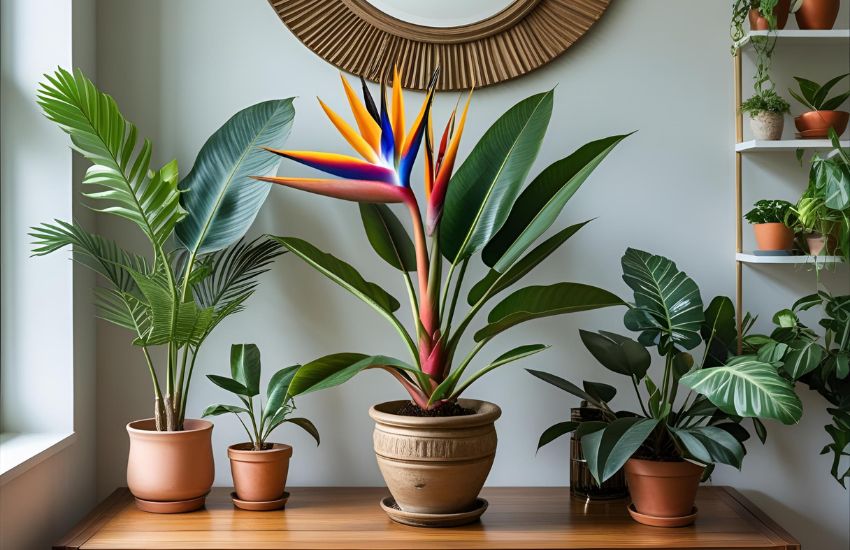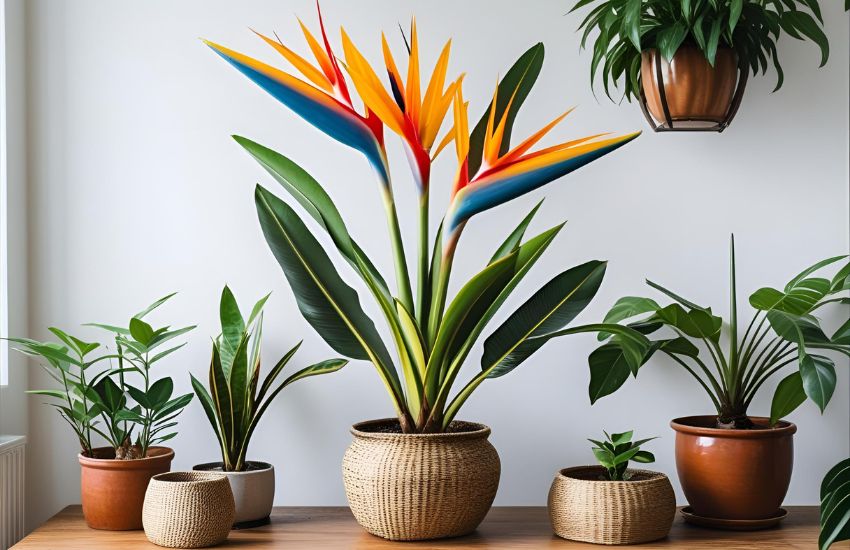Looking for a bold, tropical statement piece among your indoor plants? The bird of paradise plant, often known by its common name, the crane flower, offers just that—large, glossy foliage, vibrant structure, and exotic charm. Native to South Africa, this plant belongs to the Strelitzia genus, with popular species like Strelitzia nicolai, which resemble banana plants in form. It thrives in warm, tropical climates but can be successfully grown indoors with the right conditions.
To care for a Bird of Paradise indoors, place it in bright, indirect sunlight and water when the top 1–2 inches of soil feel dry. Maintain humidity, use well-draining soil, and fertilize monthly during spring and summer. Wipe leaves to remove dust and rotate the plant for even growth. Avoid cold drafts and overwatering.
In this guide, you’ll learn how to select the right species, care for your bird of paradise through seasonal changes, and understand how to encourage flowering indoors. From propagation and light to water and growth stages, everything you need to help your plant thrive—naturally and beautifully—is ahead.
Bird of Paradise Plant Species, Lighting Needs, and Exotic Flower Features

The bird-of-paradise is more than just a striking indoor plant—it’s a symbol of lush, exotic beauty and tropical elegance. Known for its bold structure and dramatic blooms, this plant captures the imagination of many plant enthusiasts. Understanding its key species, ideal lighting, and unique flowering process will help you give it the care it deserves.
Common Bird-of-Paradise Species
There are five main species in the Strelitzia genus, but two are most commonly grown indoors:
- Strelitzia reginae: The classic bird-of-paradise, with vibrant orange and blue flowers.
- Strelitzia nicolai: A larger variety, known for its white and blue blooms and lush, banana-like foliage.
Both species are native to South Africa and well-suited to subtropical and tropical climates. These fast-growing, perennial plants can reach heights of 6 feet indoors and spread up to 18 inches, forming tight clumps of foliage as they mature.
Lighting Needs for Healthy Growth
To thrive, bird-of-paradise plants need bright, indirect sunlight. A few hours of direct morning light can boost growth, but intense afternoon sun may damage the leaves. Position your plant near a south- or east-facing window where it can receive steady light throughout the growing season.
Low light conditions can delay flowering and slow the development of flower spikes a year, especially in younger plants. Without sufficient light, even healthy mature plants may not bloom.
The Exotic Flower: Structure and Pollination
The exotic bloom of the bird-of-paradise resembles a vibrant bird in flight. Each flower grows from a horizontal spathe, a beak-like bract that holds the colorful petal and stalk structures. These blooms emerge on tall stems and are typically supported by strong foliage.
In their natural habitat, sunbirds serve as the primary pollinator, stepping on the flower to access nectar and triggering the release of pollen. Indoors, however, this process must often be aided manually if you want to pollinate and fertilize your plant for seed propagation.
To encourage regular blooming, use a balanced fertilizer during the active growing season and ensure proper drainage and moisture control to avoid rot. Keep the soil evenly moist, but not soggy.
Propagation, Water, and Mature Growth Tips for Bird of Paradise

- Propagate Bird of Paradise effectively by dividing the rhizomes, ideally in spring when the plant is actively growing.
- Select divisions that have healthy roots and visible growth nodes for successful establishment.
- Use a well-draining soil mix enriched with perlite to prevent water retention and promote healthy root development.
- Avoid planting divisions too closely together to allow air circulation and avoid conditions that prolong root stress.
- Water deeply when the top inch of soil becomes dry, and allow the soil to dry slightly between waterings.
- Once established, the plant is tolerant of short dry periods, making it suitable for both indoor and outdoor settings.
- Provide occasional misting or place a humidity tray nearby to replicate the plant’s native tropical conditions.
- The foliage becomes dense and striking as the plant matures, with large, inches wide leaves that are deep green and slightly waxy in texture.
- Clean the leaves regularly to remove dust and maintain optimal light absorption.
- The distinctive blooms consist of a modified leaf structure, featuring vibrant blue petals and orange sepals that resemble a bird in flight.
- Bird of Paradise flowers best with adequate light—place it in full sun where possible, or in partial shade if sunlight is too intense.
- This plant performs well in coastal climates, where mild conditions allow it to flourish year-round.
- Protect the plant from freezing temperatures as cold stress can damage both roots and foliage.
- Indoors, ensure placement near a bright window to support flowering and strong leaf production.
- The plant maintains its appeal throughout the seasons with its lush evergreen foliage.
- Apply a balanced fertilizer during the growing season to encourage healthy growth and blooms.
- Repot every 2–3 years to accommodate root expansion and refresh the soil environment.
- Cultivars such as Queen Charlotte are especially admired for their large, brightly colored blooms, making them a prized choice for any gardener seeking bold tropical aesthetics.
Conclusion
Caring for a Bird of Paradise plant requires attention, patience, and an understanding of its tropical nature—but the rewards are extraordinary. From proper propagation techniques to mindful watering and long-term growth management, each step helps ensure your plant flourishes with lush, deep green foliage and striking, brightly colored blooms. Whether you’re cultivating it indoors or in a coastal garden, your efforts will be rewarded with an exotic, architectural presence that’s truly one of a kind.
Ready to elevate your plant care routine? Start by choosing a healthy Queen Charlotte division, prepare your well-draining soil with perlite, and let nature do the rest. Explore more expert tips and transform your space with the bold elegance of Bird of Paradise—because every gardener deserves a plant that inspires.
Frequently Asked Questions (How to Care for the Bird of Paradise Plant: Indoor Beauty Made Easy)
How to take care of an indoor Bird of Paradise?
To care for an indoor Bird of Paradise, place it in bright, indirect light or some direct sunlight for best growth. Keep soil consistently moist but not soggy, allowing the top inch to dry between waterings. Maintain high humidity, wipe leaves to remove dust, and fertilize monthly in spring and summer. Repot every 2–3 years.
How often do you water an indoor Bird of Paradise plant?
Water an indoor Bird of Paradise plant every 1 to 2 weeks, allowing the top 2 inches of soil to dry between waterings. In brighter light, it may need water more often, while in lower light, less frequently. Ensure proper drainage to avoid root rot and mist occasionally to maintain humidity.
Is coffee good for Bird of Paradise?
Coffee grounds can benefit a Bird of Paradise when used sparingly, as they add nitrogen to the soil and improve acidity, supporting healthy growth. However, too much coffee can compact soil, retain excess moisture, and harm roots. Always mix grounds into compost or dilute them before use to avoid over-fertilization and potential root damage.
What should I feed my Bird of Paradise plant?
Feed your Bird of Paradise plant with a balanced, water-soluble fertilizer every two to four weeks during the growing season (spring and summer). A fertilizer with equal parts nitrogen, phosphorus, and potassium works best. Reduce feeding in fall and winter when growth slows. Avoid over-fertilizing, as it may cause salt buildup and harm the roots.
